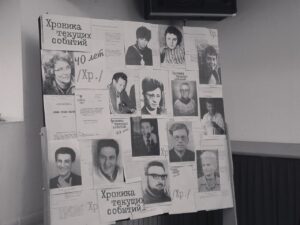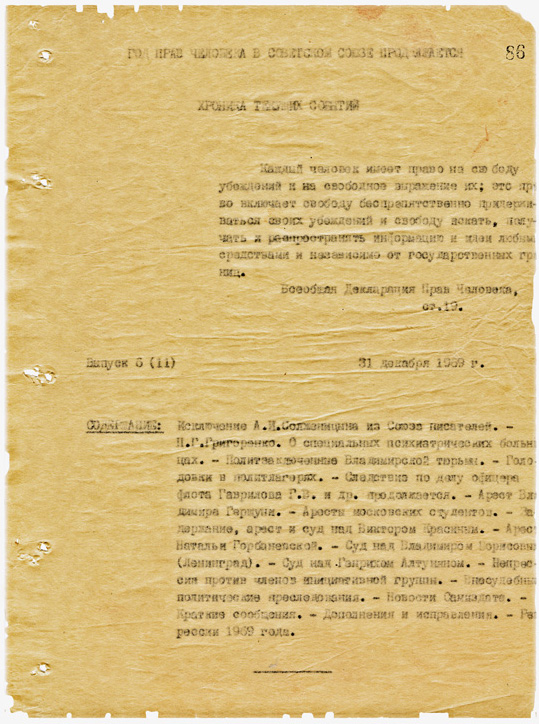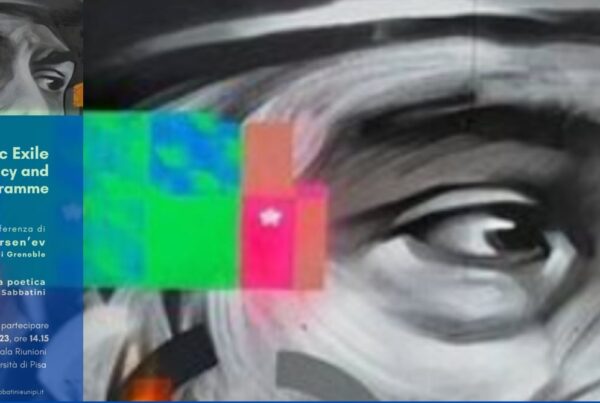
Main editors and copies of the journal. Source: Memorial Archive.
Title of the journals:
“Khronika tekuschikh sobytii” [Chronicle of current events]
Dates: 30th April 1968-31st December 1982
Place of publication: Moscow
Organizer: Natal’ia Gorbanevskaia
Editors: Natal’ia Gorbanevskaia, Anatolyi Iakobson, Sergei Kovalev, Tat’iana Velikanova, Aleksandr Lavut, Iurii Shikhanovich, Leonid Vul’, Boris Smushkevich, Aleksandr Daniėl’
Description:
“Chronicle of current events” (later known as “Chronicle”) was a typewritten news report issued between April 30th,1968 and December 31st, 1982 in 65 editions of variable length, usually released every two months. Sometimes three months passed between issues and, between December 1972 and July 1973, only one issue was published due to arrests. Printed dates did not report the date of release but when the news was gathered. The first issues were circulated a few days after the marked day, while later issues, due to their length, were published after a few months. Edition 59 (15th November 1980) remains unpublished: it was confiscated with all preliminary materials in the apartment of one of the editors’, the philologist Leonid Vul’.
The main purpose of the journal, which became a main protagonist in the USSR human rights movement, was to report news and events regarding politics, civil protests, appeals against the violation of civil rights and violence in Gulags on Soviet soil, which the official press was not willing to report on.
The journal did not contain opinions or comments; it merely reported events.
The editors of “Chronicle” never openly revealed their identities (it was edited anonymously), although the first editor is known to have been Natal’ia Gorbanevskaia, who was followed by Iurii Shikhanovich, Leonid Vul’, Boris Smushkevich and Alexander Daniėl’. It is likely that Il’ia Gabai and his wife Galina took part in the third issue dated August 1968 (cf. Alekseeva 1992; Reddaway 1972).
It was Gorbanevskaia’s idea to underline the paper’s support for the fight for civil rights by adding the subtitle “God prav cheloveka v Sovetskom Soiuze” (Year of human rights in USSR) to the first five issues, recalling the proclamation of the international year of human rights’ in 1968 and the anniversary of the international declaration signed in 1948. The first issues, up n.11 in December 1969, followed the trials of Iurii Galanskov, Aleksander Ginzburg, Aleksei Dobrovol’skii and Vera Lashkova; from n.6 to n.11 the subtitle was changed to “God prav cheloveka v Sovetskom Soiuze prodolzhaetsia” (The year of human rights in the USSR goes on). From December 1969 a wave of repression saw Gorbanevskaia confined to a psychiatric unit and charged with publishing and circulating the “Chronicle”, and Gabriel’ Superfin, Sergei Kovalev, Alexander Gavut and Tat’iana Velikanova arrested. The arrests kick-started a new human rights battle in favour of Soviet citizens in national exile. From February 1970 (n.12) to October 1972 (n.27) the journal’s subtitle was changed to: “Dvizhenie v zashchitu prav cheloveka v Sovetskom Soiuze prodolzhaetsia” (The human rights’ movement in the USSR goes on).
Following the opening of “Delo n.24” (Case n.24), which subjected the “Chronicle” to investigation for its alleged backing of anti-Soviet activists (such as the “Times” correspondent David Bonavia), the subtitle was changed again and from December 1972 to December 1976 (nn. 27-43) it became «Vystupleniya v zashchitu prav cheloveka v Sovetskom Soyuze prodolzhaiutsia” (Speeches in defense of human rights in the USSR). The “Chronicle” gave its side on “Case n.24” in n.28 (December 1972) and n.29 (July 1973) documenting searches, surveillance, and arrests of affiliates such as Irina Belogorodskaia, Andrei Sakharov, Leonid Pliushch, Petr Iakir and Viktor Krasin (on September 1st, 1973 Iakir and Krasin were sentenced to three years in concentration camps and three additional years in confinement). From March 1977 (n. 44) until the end of its run, the subtitle was changed a last time to “Borba za prava cheloveka v Sovetskom Soiuze prodolzhaetsia” (The fight for human rights in the USSR goes on; cf. Clementi 2007).
In addition to the subtitle, an epigraph of Article 19 of the Universal Declaration of Human Rights regarding freedom of opinion and expression was printed on the first page of each edition.
The contents of the “Chronicle” were divided into two sections. The first contained detailed information on single events, the second had regular thematic columns such as Aresty, obuski, doprosy (Arrests, searches, interrogations), Vnesudebnye presledovaniia (Out-of-court persecutions), V tiur’makh I lageriakh (In jails and concentration camps), Novosti samizdata (News from samizdat), Kratkie soobscheniia (Brief communications) and Ispravleniia i dopolneniia (Changes and additions).
The first issue (dated April 30th, 1968) reported on the political trials of Galanskov, Ginzburg, Dobrovol’skii and Lashkova (the trial should have started on December 11th, but was postponed to January 1968), giving biographical details about the accused, as well as describing the civil protests the trials had sparked. The paper also documented civil rights violations, non-transparent political policies, persecutions, arrests (a list of prisoners was published with short biographical details), forced labour and physical and psychiatric forms of imprisonment.
The information brought to light in the first issue concerned Moscow, Leningrad, Kiev, Novosibirsk and labour camps in Mordovia, but gradually the newspapers extended its reporting to cover other areas such as Gor’kii, Riazan’, Odessa, Solikamsk, L’vov, Tashkent and regions of Czechoslovakia, the Ukraine, Lithuania, Estonia and Armenia.
In edition n.52 (March 1st, 1979) the almanac MetrOpol’ case was reported (cf. the anonymous article Ob almanakhe Metropol’, About the almanac Metropol) and the strict sanctions on the alamanac’s writers – Vasilii Aksenov, Viktor Erofeev, Andrei Bitov, Evgenii Popov and Fazil’ Iskander – were exposed: (cf. Zalambani 2009).
“Chronicle” was reissued abroad and translated into English in the years between 1969 and 1983 (Peter Reddaway being one of the main organizers). In Italy it was distributed in 1978, edited by Pietro Sinatti for publishing house Vallecchi.
Notes: The journal can be consulted online at the Memorial Archive.
Giuseppina Larocca
[30th June 2021]
Translation by Diletta Bacci
Literature
- Alekseeva L., Istoriia inakomysliia v SSSR, Vest’, Moskva 1992: 11, 12, 27.
- Clementi M., Delo n. 24, in Id. (ed.), Storia del dissenso sovietico, Odradek Edizioni, Roma 2007: 175-183.
- Reddaway P., Introduction, in Id. (ed.), Uncensored Russia. The Human Rights Movement in the Soviet Union, Jonathan Cape, London 1972: 15-42.
- Parisi V., Il lettore eccedente. Edizioni periodiche del samizdat sovietico. 1956-1990, Il Mulino, Bologna 2013: 73, 386-387.
- Zalambani Z., Censura, istituzioni e politica letteraria in URSS (1964-1985), FUP, Firenze 2009: 49-86, 205.
To cite this article:
Giuseppina Larocca, Chronicle of current events, in Voci libere in URSS. Letteratura, pensiero, arti indipendenti in Unione Sovietica e gli echi in Occidente (1953-1991), a cura di C. Pieralli, M. Sabbatini, Firenze University Press, Firenze 2021-, <vocilibereurss.fupress.net>.
eISBN 978-88-5518-463-2
© 2021 Author(s)
Content license: CC BY 4.0





